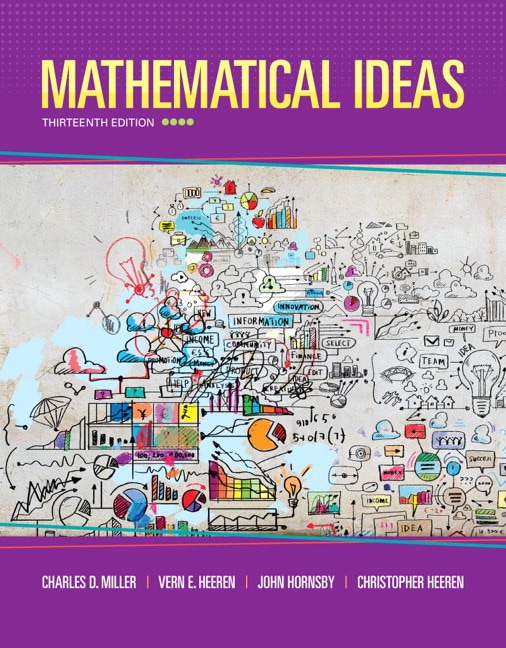
35.00$
Table of Contents
Preface
Acknowledgments
About the Authors
1. The Art of Problem Solving
1.1 Solving Problems by Inductive Reasoning
1.2 An Application of Inductive Reasoning: Number Patterns
1.3 Strategies for Problem Solving
1.4 Numeracy in Today’s World
Chapter 1 Summary
Chapter 1 Test
2. The Basic Concepts of Set Theory
2.1 Symbols and Terminology
2.2 Venn Diagrams and Subsets
2.3 Set Operations
2.4 Surveys and Cardinal Numbers
Chapter 2 Summary
Chapter 2 Test
3. Introduction to Logic
3.1 Statements and Quantifiers
3.2 Truth Tables and Equivalent Statements
3.3 The Conditional and Circuits
3.4 The Conditional and Related Statements
3.5 Analyzing Arguments with Euler Diagrams
3.6 Analyzing Arguments with Truth Tables
Chapter 3 Summary
Chapter 3 Test
4. Numeration Systems
4.1 Historical Numeration Systems
4.2 More Historical Numeration Systems
4.3 Arithmetic in the Hindu-Arabic System
4.4 Conversion between Number Bases
Chapter 4 Summary
Chapter 4 Test
5. Number Theory
5.1 Prime and Composite Numbers
5.2 Large Prime Numbers
5.3 Selected Topics from Number Theory
5.4 Greatest Common Factor and Least Common Multiple
5.5 The Fibonacci Sequence and the Golden Ratio
5.6 Magic Squares (online)
Chapter 5 Summary
Chapter 5 Test
6. The Real Numbers and Their Representations
6.1 Real Numbers, Order, and Absolute Value
6.2 Operations, Properties, and Applications of Real Numbers
6.3 Rational Numbers and Decimal Representation
6.4 Irrational Numbers and Decimal Representation
6.5 Applications of Decimals and Percents
Chapter 6 Summary
Chapter 6 Test
7. The Basic Concepts of Algebra
7.1 Linear Equations
7.2 Applications of Linear Equations
7.3 Ratio, Proportion, and Variation
7.4 Linear Inequalities
7.5 Properties of Exponents and Scientific Notation
7.6 Polynomials and Factoring
7.7 Quadratic Equations and Applications
Chapter 7 Summary
Chapter 7 Test
8. Graphs, Functions, and Systems of Equations and Inequalities
8.1 The Rectangular Coordinate System and Circles
8.2 Lines, Slope, and Average Rate of Change
8.3 Equations of Lines
8.4 Linear Functions, Graphs, and Models
8.5 Quadratic Functions, Graphs, and Models
8.6 Exponential and Logarithmic Functions, Graphs, and Models
8.7 Systems of Linear Equations
8.8 Applications of Linear Systems
8.9 Linear Inequalities, Systems, and Linear Programming
Chapter 8 Summary
Chapter 8 Test
9. Geometry
9.1 Points, Lines, Planes, and Angles
9.2 Curves, Polygons, Circles, and Geometric Constructions
9.3 The Geometry of Triangles: Congruence, Similarity, and the Pythagorean Theorem
9.4 Perimeter, Area, and Circumference
9.5 Volume and Surface Area
9.6 Transformational Geometry
9.7 Non-Euclidean Geometry and Topology
9.8 Chaos and Fractal Geometry
Chapter 9 Summary
Chapter 9 Test
10. Counting Methods
10.1 Counting by Systematic Listing
10.2 Using the Fundamental Counting Principle
10.3 Using Permutations and Combinations
10.4 Using Pascal’s Triangle
10.5 Counting Problems Involving “Not” and “Or”
Chapter 10 Summary
Chapter 10 Test
11. Probability
11.1 Basic Concepts
11.2 Events Involving “Not” and “Or”
11.3 Conditional Probability and Events Involving “And”
11.4 Binomial Probability
11.5 Expected Value and Simulation
Chapter 11 Summary
Chapter 11 Test
12. Statistics
12.1 Visual Displays of Data
12.2 Measures of Central Tendency
12.3 Measures of Dispersion
12.4 Measures of Position
12.5 The Normal Distribution
Chapter 12 Summary
Chapter 12 Test
13. Personal Financial Management
13.1 The Time Value of Money
13.2 Consumer Credit
13.3 Truth in Lending
13.4 The Costs and Advantages of Home Ownership
13.5 Financial Investments
Chapter 13 Summary
Chapter 13 Test
14. Graph Theory
14.1 Basic Concepts
14.2 Euler Circuits and Route Planning
14.3 Hamilton Circuits and Algorithms
14.4 Trees and Minimum Spanning Trees
Chapter 14 Summary
Chapter 14 Test
15. Voting and Apportionment
15.1 The Possibilities of Voting
15.2 The Impossibilities of Voting
15.3 The Possibilities of Apportionment
15.4 The Impossibilities of Apportionment
Chapter 15 Summary
Chapter 15 Test
Answers to Selected Exercises
Credits
Index of Applications
Index
NOTE: Trigonometry module and Metrics module available in MyMathLab or online at www.pearsonhighered.com/mathstatsresources.
Category : Higher Education
Instalant Download Mathematical Ideas, CourseSmart eTextbook, 13th Edition by Charles D. Miller, American River College Vern E. Heeren, American River College John Hornsby, University of New Orleans Christopher Heeren Christopher Heeren, American River College with Paypal
Mathematical Ideas, CourseSmart eTextbook, 13th Edition , buy Mathematical Ideas, CourseSmart eTextbook, 13th Edition with paypal , Charles D. Miller, American River College Vern E. Heeren, American River College John Hornsby, University of New Orleans Christopher Heeren Christopher Heeren, American River College
How can I download Mathematical Ideas, CourseSmart eTextbook, 13th Edition?
You will receive an email from testbank that contains the download link or the test bank will be attached to email
I am not able to download my test bank or solution manual ?
If you could not download your product for any reason, contact us and we will solve the issue immediately.

Comments
Post a Comment